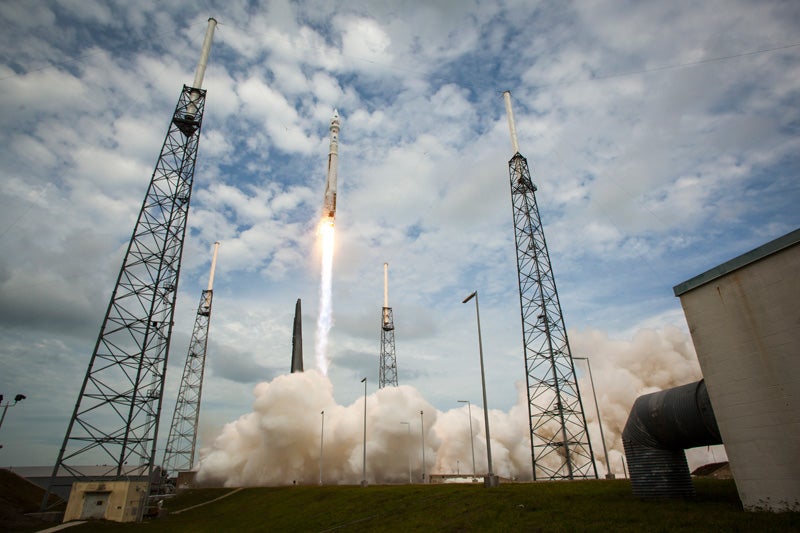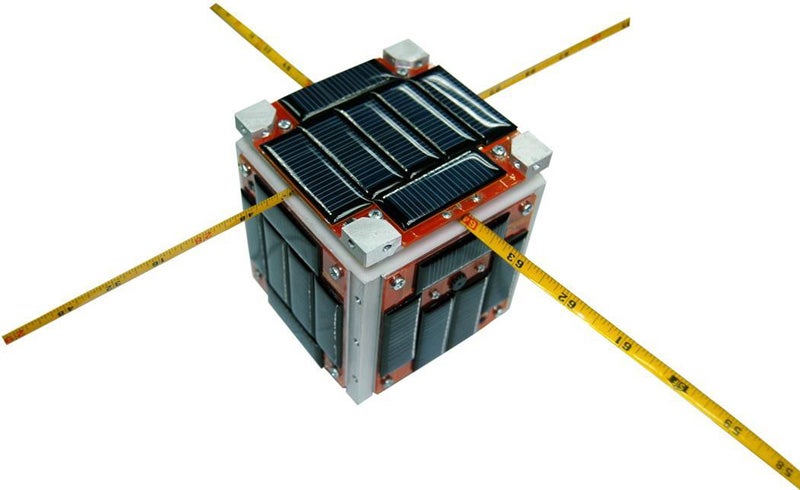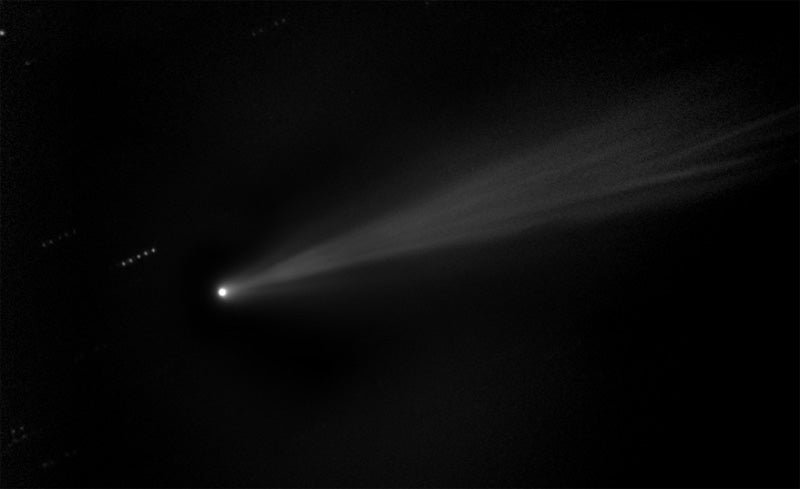The Thanksgiving comet beckons
ListenComet ISON arrives at the sun on Thanksgiving Day. Observers hope the close approach will dramatically increase dust production leading to a brighter display by Sunday, December 1st. NASA’s MAVEN mission is one-week into it’s 10-month-long trek to orbit the Red Planet, in hopes of helping to determine what happened to the water that used to be on Mars. Planets aplenty in the night sky this week; Venus west after sunset; Jupiter east by 8 p.m. rise; Jupiter, Mars, Mercury/Saturn (low and tight tomorrow morning) in a stretched line across the pre-dawn sky 5:30 – 6 am.
November 25, 2013
[Dave Heller] NASA’s MAVEN mission is one week into its 10 month-long trek to join its cohort, collecting data pertaining to the Red Planet. Let’s plug in with Derrick Pitts, chief astronomer at the Franklin Institute. Derrick, it’s a multi-pronged ground and overhead assault, and MAVEN is definitely up in the air.
[Derrick Pitts] MAVEN, along with other orbiting satellites at Mars, will all work together in a way to gather data, try to pull some information together that helps MAVEN and the scientists who have designed MAVEN to better understand what happened to the water on the surface of Mars. It’s pretty clear from all the data that’s been gathered so far that there was plenty of water on Mars at some time in its past; there’s still water frozen into the soil of Mars today. So there’s no debate about that. The question now becomes: what happened to that water, and how did that change of the water leaving the planet affect the planet’s further development? How did that change also affect the chances for life on Mars then, and what does it mean in terms of our ability to identify life on Mars now?
-

This photo provided by NASA shows the United Launch Alliance Atlas V rocket with NASA’s Mars Atmosphere and Volatile EvolutioN (MAVEN) spacecraft launching from the Cape Canaveral Air Force Station Space Launch Complex 41, Monday, Nov. 18, 2013, Cape Canaveral, Florida. NASA’s Mars-bound spacecraft, the Mars Atmosphere and Volatile EvolutioN, or MAVEN, is the first spacecraft devoted to exploring and understanding the Martian upper atmosphere. (AP Photo/NASA, Bill Ingalls)
So clearly its atmosphere has evolved over the millennia.
Yeah, and it’s really an analysis of the current Martian atmosphere as well as the interaction between the Martian atmosphere and the solar wind that arrives at Mars that will help scientists try and get a better handle on where did all that water go? I mean, in this case it’s an examination of the atmospheres of poles still looking at the surface in hopes that putting the two sets of data together — the ground data and the atmospheric data — may lead to some ideas about what happened to the water.
And then perhaps in a broader sense what is the likelihood that there are water bodies in other solar systems?
And that also has to be considered because as we look around this galaxy at least, we’re now finding so many other planets orbiting other stars. Despite what everybody says, none of them Earth-like yet, but in allowing for the possibility of these planets existing — Earth-like planets, possibly existing orbiting other stars — does that also include water in the equation?
Back to these rovers and orbiters, lets though not minimize the challenge of still getting from Earth to Mars. Apparently those efforts began by the USSR in 1960 and there are some successes littered with many lesser successes and failures.
You can come right out and call them failures. You know, the spacecraft have missed orbital insertion, crashed on orbital insertion and all sorts of things like that. If I remember correctly, out of the 10 spacecraft that we have sent to Mars, 7 have made it successfully, 3 have run into problems. But our record is still better than the Russian record, which I think out of 10 or 12 sent only one or two have been able to survive the trip. So we’re doing pretty well in that regard. It turns out that Mars is a tricky place to get a spacecraft to safely. It’s a long ways away, and of course if we’re not really prepared to deal with whatever emergencies come up when we get to the planet to establish orbit or land on the surface, there’s going to be precious little that we can do about it from this location this far out. So all of these things have to be thought of and planned for when the mission is first being pulled together so that the equipment we send and the contingency plans we have put together can make it possible for us to overcome whatever the obstacles are once we arrive at the location. It is a challenge and we’ve made it look relatively easy, but that’s not to say that it doesn’t make the engineers sweat every time a spacecraft approaches Mars.
“If I remember correctly, out of the 10 spacecraft that we have sent to Mars, 7 have made it successfully, 3 have run into problems … It is a challenge and we’ve made it look relatively easy, but that’s not to say that it doesn’t make the engineers sweat every time a spacecraft approaches Mars.”
Derrick Pitts
-
MAVEN Launch
Let’s talk about engineering satellite technology in 2013. When I think “space age” I think of the latest. Apparently we’re using smartphone technology to power those satellites.
In fact, some of the changes that are taking place right now are looking toward miniaturization of satellites. So just last week in the Minotaur 1 launch from the Mid-Atlantic Regional Spaceport at Wallops Island, Virginia, 28 satellites were placed in orbit just after launch of that spacecraft last Tuesday night. Well these 28 spacecraft are called CubeSat’s. They’re about 4 inches by 4 inches on the sides, so they are incredibly smaller than almost every other orbiting technology we’ve sent aloft. And in one of them, the satellites on board, electrical operations are run by smartphone technologies. So looking forward down the road, here’s an opportunity to redesign how we go about creating spacecraft for orbit in which we may be able to get the package into a much smaller size so that it’s much more economical and based on smartphone electronics can do a tremendous amount because there’s a GPS, high-resolution cameras and all the other internal technologies that we’ve been able to make use of here that are certainly applicable there.
-

NanoRacks-FPTU CubeSat-1, designed and manufactured by F space laboratory, deploys from the International Space Station. Image courtesy of NanoRacks, LLC.
Derrick, many of us anticipating the Thanksgiving feast would welcome the opportunity for pre-emptive or post-emptive, if you will, opportunities to get out of doors. What’s available in the night sky this week? We devoted lots of time to Comet ISON last week — is that still around?
Comet ISON is indeed still around, and it comes to its closest approach to the sun this Thursday at 6 p.m., the reason why I call it the “Thanksgiving Comet.” Now between now and then, it’s far too close to the sun for us to be able to see easily in the pre-dawn sky. However, come this weekend, it should be pushing out far enough away from the sun again in the pre-dawn sky over in the east about 30 minutes before sunrise. By Sunday we should be able to see the comet with a tail on it as it recedes out of the solar system over the next three weeks. So again, this is a pre-dawn sky observation. You’ll have to be out about 30 to 45 minutes before sunrise, and you’ll be able to see the comet low on the horizon this weekend and then subsequently as the comet moves out of the solar system, it will rise higher and higher in the pre-dawn sky. Its visibility though will decrease as its brightness decreases as its distance from the sun decreases. However, the hope is that the interaction from the sun will have generated a much better tail display than what we’ve seen as the comet has been coming in toward the sun.
Telescope preferred, but will binoculars suffice?
Hopefully this is a naked eye object, assisted by binoculars. And then as we get two weeks out then three weeks out, we might find that we need a small telescope to continue following it.
How about some naked eye planet visibility?
There are great planets to be seen in the sky this week. Over in the southwestern sky after sunset, Venus is absolutely brilliant. Bright white, not very high in the sky, but through the next week or so we’ll be able to see it without any difficulty at all. If we wait just another hour and a half or so later, by 8:30 in the evening over on the eastern side of the sky we find Jupiter is coming up above the eastern horizon and will be visible all night. If we go to the pre-dawn sky we get a real treat because not only will we be able to see Jupiter, but we can also see Mars along with it as we come down toward the eastern horizon. And then tomorrow morning in particular down low close to the eastern horizon about 30 minutes before sunrise, 45 minutes before sunrise we find Mercury and Saturn very tight and close together. They’ll be spreading apart as we go through the week. But this gives you an opportunity to see four planets in the pre-dawn sky: Jupiter, Mars, Saturn and Mercury together low on the eastern horizon.
Plenty to be thankful for. And Derrick, wishing yours a great Thanksgiving holiday weekend, let’s do it again next week.
Thanks, and same to you, Dave.
-

Comet ISON enhanced: Taken on Nov. 19, 2013, this image shows a composite “stacked” image of comet ISON. These five stacked images of 10 seconds each were taken with the 20″ Marshall Space Flight Center telescope in New Mexico. This technique allows the comet’s sweeping tail to emerge with more detail. Image credit: NASA/MSFC/MEO/Cameron McCarty
WHYY is your source for fact-based, in-depth journalism and information. As a nonprofit organization, we rely on financial support from readers like you. Please give today.




